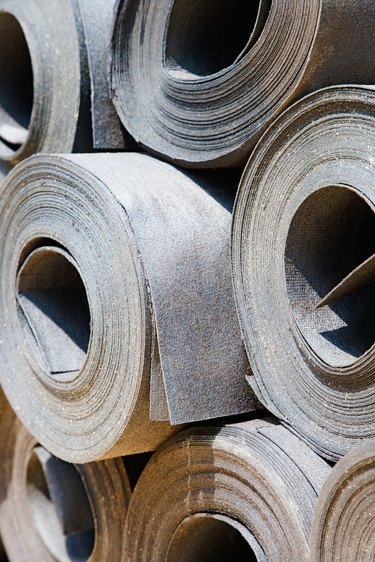
Traditional roofing felt, also called tar paper or underlayment, is "felt" saturated with bitumen, also called asphalt. Felt is compressed fibers of wool. Roofing felt is made of compressed polyester or fiberglass fibers. Bitumen or asphalt is distilled from petroleum and is what makes roofing felt waterproof. Some newer roofing felts are made of black polypropylene.
Underlayment
Video of the Day
Roofing felt is most often used as an underlayment, or layer between the roof deck and shingles, tiles or metal panels on roofs with steep slopes. A steep roof is 4:12 or greater, meaning that the roof rises four feet for every 12 feet of length. High winds can push water or snow up the roof and under shingles or tiles. An underlayment of waterproof felt blocks the water. Ice in gutters and downspouts can also back water up under shingles and tiles. This phenomenon, called "damming," is why waterproof felt underlayments are necessary in cold climates. Many insurance companies and building codes require a felt underlayment beneath shingles.
Video of the Day
Temporary Roof Protection
Waterproof roofing felt gives the roof temporary protection from rain while you apply shingles, tiles or other roof coverings. It is safe to walk on. Roofing felt is not designed as a permanent exterior barrier against water.
Thickness and Waterproofing
You can buy roof felt in No. 15 and No. 30 thickness. A No. 15 can bear 15 pounds of load. A No. 30 can bear 30 pounds of load. A No. 30 does not shed water better than a No. 15, but it resists tearing, so it is safer if you are installing coverings on a steep roof. In warm climates, felt roofing is used instead of metal to line roof valleys.
Proper Installation
Felt roofing is meant to shed water, but you need to lay it properly. If you wrinkle felt roofing, it can crack, causing leaks. Watch for tears or holes in the felt. Make sure to overlap the felt when you install it.
Caution
Older roofing felt that contained asbestos was phased out in the 1980s as being a health hazard if it crumbles and is inhaled. If you are removing and replacing older roofing felt that contains asbestos, store it in plastic bags and dispose of it at a toxic waste facility.